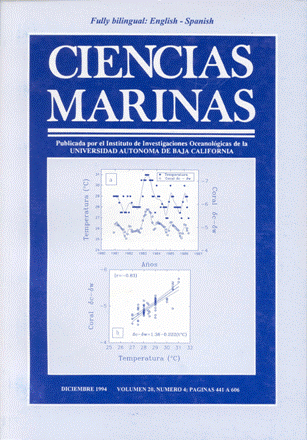Biofacies and taphofacies of a Holocene macrotidal environment: Bahia La Cholla, Northern Gulf of California
Main Article Content
Abstract
Recognition of the paleoenvironmental significance of biofacies and taphofacies in the fossil record is greatly aided by their study in modern sedimentary environments. Holocene molluscan shell assemblages of Bahia la Cholla, a macrotidal shallow marine environment in the northern Gulf of California, form distinct biofacies and taphofacies whose distribution is controlled by different environmental variables. Biofacies primarily reflect variation in substrate. Distinctive molluscan communities characterize: 1) Salt marsh and innermost tidal flats: organic-rich fine sediments, dominated by epifaunal deposit feeders and deep infauna! suspension feeders; 2) Inner, middle and outer tidal flats: fine to coarse sand, dominated by shallow infaunal suspension feeders; 3) Tidal channel and rocky intertidal zone: hard substrates of shells or rock, dominated by epifaunal algal grazers; 4) Rocky subtidal zone: alternating rock and sand, dominated by attached epifaunal suspension feeders and shallow infaunal suspension feeders. Taphofacies, based on taphonomy of the shallow infaunal bivalve Chione spp., primarily reflect variation in tidal submergence time and current energy. Distinctive suites of taphonomic attributes characterize: 1) Outer tidal flats, rocky intertidal zone, and rocky subtidal zone: environments experiencing prolonged or continuous tidal submergence and high tidal current velocities, characterized by high levels of abrasion, bioerosion by bivalves and clionid sponges, and encrustation by bryozoans; 2) Tidal channel: an environment experiencing continuous submergence and the strongest tidal currents, characterized by very high levels of abrasion, bioerosion by algae, and encrustation by serpulid polychaetes; 3) Sall marsh, inner tidal flats and middle tidal flats: environments experiencing relatively short periods of submergence and low tidal current velocities, characterized by low levels of taphonomic alteration. Biofacies and taphofacies provide different and complementary types of information about the sedimentary environments of Bahia la Cholla. In paleoecological studies, a more complete picture of ancient environments can be generated by integrating taphonomic data with taxonomic and ecologic data.
Downloads
Article Details
This is an open access article distributed under a Creative Commons Attribution 4.0 License, which allows you to share and adapt the work, as long as you give appropriate credit to the original author(s) and the source, provide a link to the Creative Commons license, and indicate if changes were made. Figures, tables and other elements in the article are included in the article’s CC BY 4.0 license, unless otherwise indicated. The journal title is protected by copyrights and not subject to this license. Full license deed can be viewed here.

